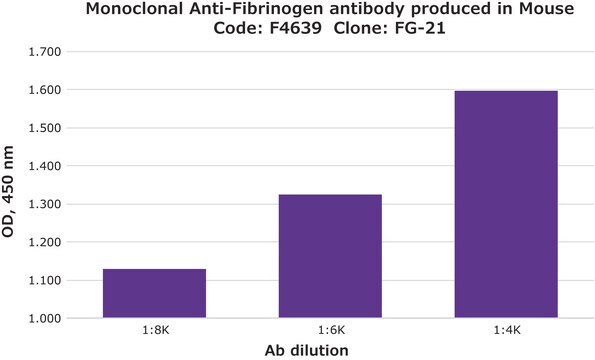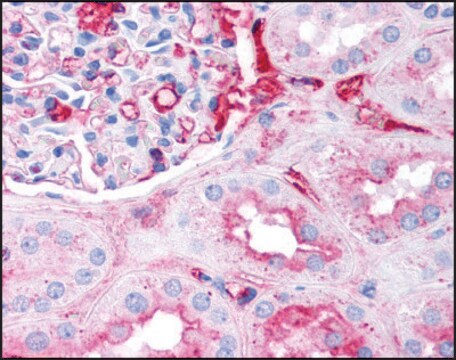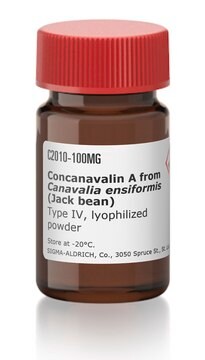F9902
Monoclonal Anti-Fibrinogen antibody produced in mouse
clone 85D4, ascites fluid
Synonym(s):
Anti-Fib2
Sign Into View Organizational & Contract Pricing
All Photos(1)
About This Item
Recommended Products
biological source
mouse
conjugate
unconjugated
antibody form
ascites fluid
antibody product type
primary antibodies
clone
85D4, monoclonal
contains
15 mM sodium azide
species reactivity
pig, sheep, rabbit, bovine, baboon, human, goat, canine
technique(s)
dot blot: suitable
indirect ELISA: 1:8,000
western blot: suitable
isotype
IgG1
UniProt accession no.
shipped in
dry ice
storage temp.
−20°C
target post-translational modification
unmodified
General description
Fibrinogen is a blood coagulation protein that consists of Aα, Bβ and γ polypeptide chains. Fibrinogen expression is induced by acute-inflammatory responses and has also been associated with the risk of cardiovascular disorders. Monoclonal Anti-Fibrinogen antibody recognizes a conformational epitope, which is destroyed by the cleavage of the γ (302-303) bond. This epitope is found in fibrinogen and in fibrin monomers (devoid of either fibrinopeptide A, or both A and B fibrinopeptides), when they are immobilized on ELISA plates. The antibody reacts with the D-dimer and D-fragment. It does not recognize individual fibrinogen/fibrin chains in denatured-reduced forms or their proteolytic fragments. The E fragment is not recognized by the antibody. The antibody reacts with greater avidity with protofibrils than with wider fibrin fibers in electron microscopic analysis. Monoclonal Anti-Fibrinogen is specific for fibrinogen and fibrin in humans, baboons, bovines, sheep, goats, pigs, rabbits and dogs.
Fibrinogen was the first blood coagulation factor to be identified, and it is a precursor of fibrin protein. The three polypeptide chains are coded by three genes located on human chromosome 4q23-q32, and spans 51kb.
Specificity
The product recognizes a conformational epitope, which is destroyed by the cleavage of the γ (302-303) bond. This epitope is found in both fibrinogen and in fibrin monomers, devoid of either fibrinopeptide A, or both A and B fibrinopeptides, when they are immobilized on ELISA plates. The antibody reacts with the D-dimer and D-fragment. It does not recognize individual fibrinogen/fibrin chains in the denatured-reduced form and their proteolytic fragments. The E fragment is not recognized by the antibody. Using electron microscopy, the antibody reacts with greater avidity with protofibrils than with wider fibrin fibers.
Immunogen
human fibrin degradation products
Application
Applications in which this antibody has been used successfully, and the associated peer-reviewed papers, are given below.
Immunofluorescence (1 paper)
Immunofluorescence (1 paper)
Monoclonal Anti-Fibrinogen antibody is suitable for use in indirect ELISA, dot blot (1:1000 using human fibrinogen), and western blot.
Monoclonal Anti-Fibrinogen antibody produced in mouse has been used in immunohistochemistry and confocal laser scanning microscopy.
Biochem/physiol Actions
Fibrinogen is an acute-phase inflammatory protein, which plays an essential role in blood clotting.
Disclaimer
Unless otherwise stated in our catalog or other company documentation accompanying the product(s), our products are intended for research use only and are not to be used for any other purpose, which includes but is not limited to, unauthorized commercial uses, in vitro diagnostic uses, ex vivo or in vivo therapeutic uses or any type of consumption or application to humans or animals.
Not finding the right product?
Try our Product Selector Tool.
Storage Class Code
10 - Combustible liquids
WGK
nwg
Flash Point(F)
Not applicable
Flash Point(C)
Not applicable
Choose from one of the most recent versions:
Already Own This Product?
Find documentation for the products that you have recently purchased in the Document Library.
J Alfon et al.
Atherosclerosis, 145(2), 325-331 (1999-09-17)
HMG-CoA reductase inhibitors have been shown to be effective in primary and secondary prevention of coronary heart disease. Their mechanism of action is attributed to their cholesterol lowering activity but recent results seem to indicate additional effects related to the
Suttnar, J., et al.
Thrombosis and Haemostasis, 69, 1156-1156 (1993)
Dyr, J.E., et al. et al.
Thrombosis and Haemorrhagic Disorders, 166-171 (1989)
Laura Casani et al.
Thrombosis and haemostasis, 94(5), 1035-1041 (2005-12-21)
Inhibitors of 3-hydroxy-3-methylglutaryl coenzymeA reductase are widely used in the management and prevention of cardiovascular disease. In addition to its major activity, plasma lipid lowering, statins have shown a wide spectrum of additional effects that may contribute to their benefits
C M Adema et al.
Parasitology, 119 ( Pt 4), 395-404 (1999-12-03)
The planorbid snail Biomphalaria glabrata responded to exposure to either the compatible digenetic trematode Echinostoma paraensei or the incompatible species Echinostoma trivolvis by producing increased amounts of several distinctive plasma polypeptides. These polypeptides characteristically precipitated from plasma when mixed with
Our team of scientists has experience in all areas of research including Life Science, Material Science, Chemical Synthesis, Chromatography, Analytical and many others.
Contact Technical Service








